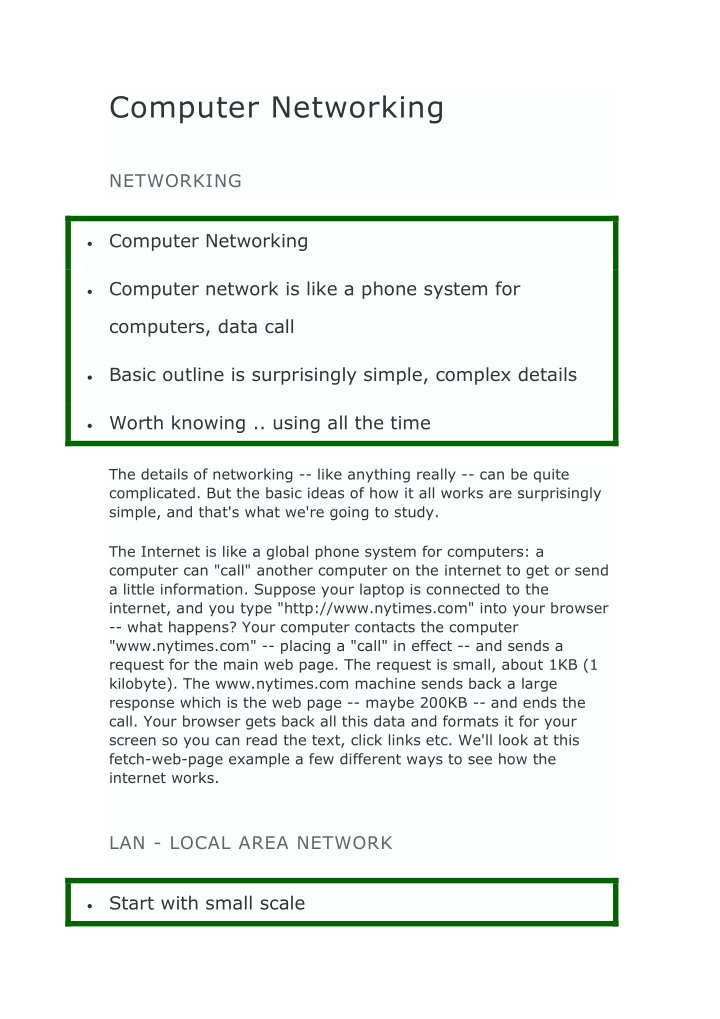



Computer Networking NETWORKING Computer Networking Computer network is like a phone system for computers, data call Basic outline is surprisingly simple, complex details Worth knowing .. using all the time The details of networking -- like anything really -- can be quite complicated. But the basic ideas of how it all works are surprisingly simple, and that's what we're going to study. The Internet is like a global phone system for computers: a computer can "call" another computer on the internet to get or send a little information. Suppose your laptop is connected to the internet, and you type "http://www.nytimes.com" into your browser -- what happens? Your computer contacts the computer "www.nytimes.com" -- placing a "call" in effect -- and sends a request for the main web page. The request is small, about 1KB (1 kilobyte). The www.nytimes.com machine sends back a large response which is the web page -- maybe 200KB -- and ends the call. Your browser gets back all this data and formats it for your screen so you can read the text, click links etc. We'll look at this fetch-web-page example a few different ways to see how the internet works. LAN - LOCAL AREA NETWORK Start with small scale
LAN - Local Area Network One house, one floor of a building Later, show scale up to world-wide internet e.g. Ethernet, wired LAN e.g. Wi-Fi, wireless LAN We'll start by looking at LAN (local area network) technology -- connecting 2-50 computers in a house or on one floor of a building. ETHERNET LAN Ethernet Very ubiquitous wired LAN technology Wires about as thick as a drinking straw 100 meter max wire length -- local Wires often yellow or blue RJ-45 plug, like a big phone plug
Ethernet RJ45 plug Ethernet cables plugged into the back of a Wi-Fi router
Ethernet is an extremely common and influential wired LAN standard, so we'll start there. Ethernet cable lengths are typically limited to 100 meters, in keeping with its "local" orientation. A typical LAN application is networking the computers in one room or in one floor of a building. The most common form of ethernet wiring is 100base-T (100 megabit) with "RJ-45" connectors on the ends. An RJ-45 connector is about the size of your pinkie finger, like a wide phone wire plug. PACKETS - DATA FROM HERE TO THERE Send image from one computer to another on ethernet This is the "one hop" case (scale up to whole world later) e.g. 50KB image.jpg 50,000 bytes How to send the image.jpg on the wire? Packets Divide bytes of image.jpg into packets Say each packet is 1500 bytes (varies) Then image.jpg divides into about 32 packets Ethernet: transmit one packet between computers
We'll start with the simplest case of two computer connected with an ethernet cable, and we want to send a 50KB jpeg image file from one computer to the other. This is the "one-hop" case .. networking between two computers separated only by an ethernet cable. Below we'll scale this up to the full Internet case of two computers on separate sides of the world. The first question is: how are the bytes of the image file on one computer sent to the other computer over the rather skinny ethernet cable? For transmission, the 50KB of the image is divided into packets . The packet is the natural unit of transmission within networking. In this case, say each packet is about 1500 bytes (a typical ethernet packet size), then the bytes of the 50KB image could be divided into about 32 packets. It is not required that all the packets be the same size, just that every byte of the image is sent in one packet or another. ETHERNET -- SENDING ONE PACKET Look at transmission of one 1500 byte packet Each byte is 8 bits, e.g. 0 1 1 0 1 0 1 0 Send each byte (slight simplification): Go through 0/1 bits, left to right
--For each 1, put 3 volts on the wire --For each 0, put 0 volts on the wire Receive --Follow along the pattern of 3 volts / 0 volts coming down the wire --Assemble the 0's and 1's to make each byte digital transmission - just 0's and 1's Ethernet provides a basic facility to transmit a packet between two computers connected by the ethernet cable. Say we have a packet of 1500 bytes of information we want to send. Each byte is 8 bits, so that's 12000 bits to send, where each bit is a 0 or 1. Here's an oversimplification that captures how it works: the ethernet cable contains two wires connecting the computers. The sending computer could read through the 12000 bits in order, and for each 1 bit, put 3 volts between the wires, and for each 0 bit, put 0 volts between the wires. The receiving computer can follow along, noting the 3v/0v pattern on the wires over time and so receive the 12000 bits. In reality the most recent ethernet contains 4 pairs of wires and supports sending information in both directions and with a more complex voltage scheme. However, this pattern of going
Recommend
More recommend